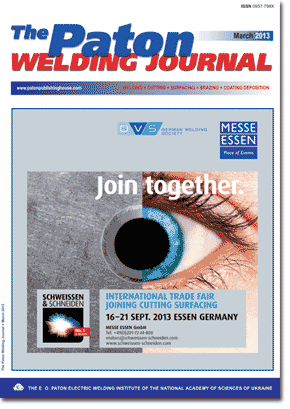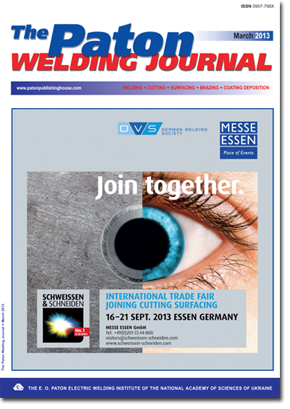| 2013 №03 (03) | 2013 №03 (05) |

The Paton Welding Journal, 2013, #3, 18-23 pages
INFLUENCE OF WELDING PROCESSES ON THE STRUCTURE AND MECHANICAL PROPERTIES OF WELDED JOINTS OF ALUMINUIM ALLOY 1460
L.I. MARKASHOVA, A.G. POKLYATSKY and O.S. KUSHNARYOVA
E.O. Paton Electric Welding Institute, NASU, Kiev, Ukraine
Abstract
An essential difference in formation of structural-phase state of weld metal of aluminium alloy 1460 at application of various technological conditions of welding is shown. In nonconsumable electrode argon-arc welding the weld metal is characterized by an essential increase of the dimensions of phase precipitates in inner grain bulk, formation of massive extended eutectics of intergranular type, as well as a pronounced coarsening of granular structure, that is related to active development of the processes of collective recrystallization under the impact of temperature mode of welding. Structural-phase state of weld metal under the conditions of friction stir welding is characterized by a more marked dispersion of phase precipitates and their uniform distribution, as well as grain refinement as a result of dynamic recrystallization, due to intensive impact of deformation processes localized in the welding zone. 11 Ref., 6 Figures.
Keywords: aluminium alloy 1460, nonconsumable electrode argon-arc welding, friction stir welding, phase precipitates, dislocation strengthening, strength characteristics
Received: 15.01.13
Published: 28.03.13
References
1. Fridlyander, I.N. (2000) Aluminium alloys in flying vehicles in the periods from 1970 to 1999 and from 2000 to 2015. In: Proc. of 5th Session of Sci. Council on Advanced Materials of IAAS on Problems of Current Materials Science. Kiev: Naukova Dumka.
2. Fridlyander, I.N. (1998) Aluminium alloys in aeronautical engineering. In: Proc. of 3rd Session of Sci. Council on Advanced Materials of IAAS on Problems of Current Materials Science. Kiev: Naukova Dumka.
3. Darovsky, Yu.F., Markashova, L.I., Abramov, N.P. et al. (1985) Procedure of thinning of dissimilar welded joint specimens for electron microscopic examinations. Avtomatich. Svarka, 12, 60.
4. Suzuki, H. (1967) About yield strength of polycrystalline metals and alloys. Moscow: Metallurgiya, 255-260.
5. Ashby, M.F. (1972) On Orowan stress. In: Physics of strength and ductility. Moscow: Metallurgiya.
6. Goldshtejn, M.I., Litvinov, V.S., Bronfin, B.M. (1986) Physics of metals of high-strength alloys. Moscow: Metallurgiya.
7. Conrad, H. (1973) Model of deformation strengthening to explain the grain size influence on metal yield stress. In: Ultrafine grain in metals. Ed. by L.K. Gordienko. Moscow: Metallurgiya, 206-219.
8. Armstrong, R.V. (1973) Strength properties of ultrafine grain metals. Ibid., 11-40.
9. Petch, N.J. (1953) The cleavage strength of polycrystalline. J. Iron and Steel Inst., 173(1), 25-28.
10. Orowan, E. (1954) Dislocation in metals. New York: AIME.
11. Ashby, M.F. (1983) Mechanisms of deformation and fracture. Adv. Appl. Mech., 23, 117-177.
Suggested Citation
L.I. MARKASHOVA, A.G. POKLYATSKY and O.S. KUSHNARYOVA (2013) INFLUENCE OF WELDING PROCESSES ON THE STRUCTURE AND MECHANICAL PROPERTIES OF WELDED JOINTS OF ALUMINUIM ALLOY 1460. The Paton Welding J., 03, 18-23.The cost of subscription/purchase order journals or individual articles
| Journal/Currency | Annual Set | 1 issue printed |
1 issue |
one article |
| TPWJ/USD | 384 $ | 32 $ | 26 $ | 13 $ |
| TPWJ/EUR | 348 € | 29 € | 24 € | 12 € |
| TPWJ/UAH | 7200 UAH | 600 UAH | 600 UAH | 280 UAH |
| AS/UAH | 1800 UAH | 300 UAH | 300 UAH | 150 UAH |
| AS/USD | 192 $ | 32 $ | 26 $ | 13 $ |
| AS/EUR | 180 € | 30 € | 25 € | 12 € |
| SEM/UAH | 1200 UAH | 300 UAH | 300 UAH | 150 UAH |
| SEM/USD | 128 $ | 32 $ | 26 $ | 13 $ |
| SEM/EUR | 120 € | 30 € | 25 € | 12 € |
| TDNK/UAH | 1200 UAH | 300 UAH | 300 UAH | 150 UAH |
| TDNK/USD | 128 $ | 32 $ | 26 $ | 13 $ |
| TDNK/EUR | 120 € | 30 € | 25 € | 15 € |
AS = «Automatic Welding» - 6 issues per year;
TPWJ = «PATON WELDING JOURNAL» - 12 issues per year;
SEM = «Electrometallurgy Today» - 4 issues per year;
TDNK = «Technical Diagnostics and Non-Destructive Testing» - 4 issues per year.


